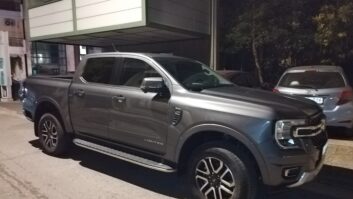
Andy Sennitt is a retired Radio Netherlands Worldwide strategic advisor.
Photo courtesy of Andy SennittOTTAWA — Norway has begun shutting down some of its FM radio transmitters, replacing them with digital audio broadcasts. Over the next year, the country’s national and some commercial local stations in larger cities will make the move to DAB-only transmissions. Norwegian community radio and small local stations are being allowed to remain on FM. They can do so for the next five years, at which point Norway’s government will review their FM licenses.
Switzerland has also committed to eliminating all FM transmissions by 2024, with the first FM stations to start turning off their transmitters beginning in 2020. Meanwhile, the BBC reported on Jan.10 that “Denmark and the U.K. are also considering a switch-off.” Sweden had committed to switching off FM in 2022, but the government has since dropped the plan due to public pressure.
Clearly, there is a push among some European countries to supersede FM in favor of DAB. But critics argue that DAB’s ascendancy does not mean that European FM is doomed.
NORWAY DECISION

If Switzerland has its way, DAB receivers will replace FM radios there by 2024.
Photo courtesy of the Swiss National Broadcasting Corporation Norway’s decision to shut down FM and replace it with DAB was announced by the country two years ago. “The government has set a date for the switch-off of Norway’s FM radio stations, having concluded that the criteria for the technology shift are now met,” said a Norwegian government news release on April 16, 2015.
Under Norway’s criteria, “the coverage of (state broadcaster) NRK’s digital radio services must correspond to that of the channel NRK P1 on FM. The multiplex that carries commercial national services (Riksblokka) must cover at least 90 percent of the population.” As well, Norwegians had to have access to “affordable and technically satisfactory solutions” for in-car DAB reception.
Money was a major reason for Norway to make the switch. “DAB is a lot cheaper to operate than FM,” said Andy Sennitt, retired Radio Netherlands Worldwide strategic advisor. “You can have a much wider range of services from each site without the need for multiple transmitters.”

Increasingly, DAB receivers such as this model from Pure will be the way Europeans will listen to radio.
Photo courtesy of Wiki Commons Meanwhile, moving to DAB from FM has already provided major benefits to Norway radio listeners, said Mari Hagerup, head of Communication, Media and External Relations for Digitalradio Norge AS, the Norwegian company charged with implementing Norway’s transition from FM to DAB. “By moving to digital the national number of stations has risen from 5 to 30,” she said. “All new stations were launched on DAB as the FM network does not have enough capacity for new national radio stations.”
“Seventy percent of all households had a DAB radio at the time of the shift,” she added, which means that 70 percent of Norway’s population was already listening to DAB everyday by the time the FM shutdown began. “There are still households in need of upgrading radios — but the transition has happened gradually,” said Hagerup.
Norway’s move to shutter FM does not sit well with the Norsk lokalradioforbund, which represents local radio broadcasters in the country. In fact, four local stations in Norway’s largest cities are protesting the enforced FM shutdown to the EFTA Surveillance Authority (ESA), which monitors Norway’s legislative compliance with European Union rules.
“DAB has always been an advantage for the big players and not for local radio,” said Svein Larsen, the Norsk lokalradioforbund’s chairman. “The public has never embraced DAB, because it is difficult for them to see what the added value is compared to FM. More music channels for the same broadcasting companies does not mean more media diversity for listeners.”
WHY SWITZERLAND WILL DO IT

Located off Scotland’s north coast, the remote Shetland Islands are more economically served by FM than DAB.
Photo courtesy of Marion McCune/Wiki Commons Switzerland has its own criteria for shutting down FM in favor of DAB, and the digital radio band has met these criteria. “There are eight DAB+ multiplexes in Switzerland presently carrying 127 radio programs,” said Niklaus Kühne, head of Technical Communications for the Swiss National Broadcasting Corp.’s Operations department. “Coverage is between 70 to 99 percent, depending on the multiplex. SRG, the Swiss national public broadcaster, operates four multiplexes with 99 percent coverage.”
As to how many Swiss are listening to DAB? “Some 70 percent of radio receivers sold for home use and in cars already boast of DAB+ reception,” he said. “We have just started an intense two-year national campaign in order to raise this figure further.”
Given the lower cost of DAB radio coverage compared to its FM equivalent, the additional number of services that DAB can carry compared to the FM band, and the fact that DAB’s digital audio offers better quality than analog FM, the push by many European broadcast authorities to replace FM with DAB is understandable.

Some day soon, this 1959 vintage Fisher AM/FM radio may seem as foreign to European DAB listeners as a gramophone is to iPod users.
Photo courtesy of Gregory F. Maxwell/Wiki Commons However, European radio listeners don’t necessarily share this enthusiasm. “In a poll conducted by the daily newspaper Dagbladet, around two-thirds of Norwegians said the government was acting too fast,” reported The Guardian newspaper’s website. “Much of the discussion has centered on the elderly and fears that they could be left isolated because they have neither the money nor the technical knowhow to make the transition. DAB sets for the home cost around 1,000 kroner (US$145).” The Norwegian government is not providing money to help these people buy DAB receivers, said Hagerup.
Beyond the cost and tech-shock of moving to DAB from FM for some listeners, the fact that DAB has yet to reliably duplicate FM’s European coverage is also a concern for the continent’s radio audience.
“What we see in Europe at the moment is ‘the leopard’ model, also known as ‘spotted digitization’ because some rural and remote areas lack adequate DAB coverage,” said Ruxandra Obreja, chair of the Digital Radio Mondiale consortium; the international group promoting the DRM digital radio transmission system. “In urban and built-up areas, DAB works; it is efficient and certainly saves money,” she said. “The question is whether DAB can offer the same service to all European citizens no matter where they live, in rural France or small town Slovenia.”

The Swiss Broadcasting Corp.’s head office in Bern, Switzerland.
Photo courtesy of the Swiss Broadcasting Corporation “Many European countries are setting up DAB networks, but it has not succeeded everywhere,” said Sennitt. “In Finland, the DAB project was abandoned because it only offered the same services as FM at a higher bitrate, which effectively meant better audio quality. But this alone did not encourage people to buy DAB receivers. There has to be a unique selling point that will encourage people to upgrade; such as additional audio services on DAB that are not found on FM.”
Community and small commercial FM broadcasters on tight budgets don’t want to move to digital, because “DAB is still far too expensive for the smallest radio stations,” said Nigel Peacock, presenter and administrator of Eden FM Radio Ltd., which broadcasts on 107.5 FM just south of the Scottish/English border. “The cost of carriage on commercial multiplexes is well beyond the reach of community radio stations such as ourselves.”
“There are many mixed rural and urban communities, and islands groups, like Scotland’s far northern Shetland Islands, where DAB is not a practical and affordable solution for a local radio station,” said Ian Anderson, engineering director of the Shetland Islands Broadcasting Co. “In SIBC’s case, at least five, maybe nine, DAB transmission sites would be needed to give the Shetland Islands the same coverage as a single FM site.”
“It took many years, but the regulator Ofcom and the U.K. government have finally recognized this fact of physics,” Andersen added. “SIBC’s FM license was therefore renewed for 12 years until October 2028.”
FM IS NOT DONE YET
Niklaus Kühne, Head of Technical Communications for the Swiss National Broadcasting Corp.’s Operations department.
Photo courtesy of the Swiss Broadcasting Corporation The fact that DAB is currently not cost-effective for covering remote areas like the Shetland Islands, plus the proven need for national DAB services to offer more content than FM to drive the sales of DAB receivers, means that the case for DAB to replace FM across all of Europe does not yet exist.
Moreover, “the European Commission is not going to mandate one single digital solution to all 28 EU countries,” said Obreja, who noted that the EC recently confirmed that to her in writing. “They leave it to the country authorities and the industry. Sometimes the public is involved as well, although this is a bit facetious; as no street protests have taken place in European cities demanding digital radio yet!”
Meanwhile, many of Europe’s successful commercial FM stations do not “see an advantage in digital radio, which can and should open the door to new stations, invention and new content in the often congested spectrum allocation — thus adding competition for listeners for a slice of the advertising pie,” Obreja observed.
As a result, although European nations such as Norway and Switzerland are pushing ahead with FM shutdowns, the medium itself seems not to be doomed continent-wide; at least not for the foreseeable future.
James Careless reports on the industry for Radio World from Ottawa, Ontario.







